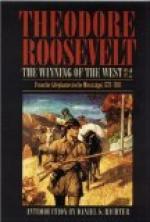The point pitched upon was the beautiful country lying along the great bend of the Cumberland. Many adventurous settlers were anxious to accompany Robertson, and, like him, to take their wives and children with them into the new land. It was agreed that a small party of explorers should go first in the early spring, to plant corn, that the families might have it to eat when they followed in the fall.
The Cumberland Country.
The spot was already well known to hunters. Who had first visited it cannot be said; though tradition has kept the names of several among the many who at times halted there while on their wanderings. [Footnote: One Stone or Stoner, perhaps Boon’s old associate, is the first whose name is given in the books. But in both Kentucky and Tennessee it is idle to try to find out exactly who the first explorers were. They were unlettered woodsmen; it is only by chance that some of their names have been kept and others lost; the point to be remembered is that many hunters were wandering over the land at the same time, that they drifted to many different places, and that now and then an accident preserved the name of some hunter and of some place he visited.] Old Kasper Mansker and others had made hunting trips thither for ten years past; and they had sometimes met the Creole trappers from the Illinois. When Mansker first went to the Bluffs, [Footnote: The locality where Nashborough was built, was sometimes spoken of as the Bluffs, and sometimes as the French Lick.] in 1769, the buffaloes were more numerous than he had ever seen them before; the ground literally shook under the gallop of the mighty herds, they crowded in dense throngs round the licks, and the forest resounded with their grunting bellows. He and other woodsmen came back there off and on, hunting and trapping, and living in huts made of buffalo hides; just such huts as the hunters dwelt in on the Little Missouri and Powder rivers as late as 1883, except that the plainsmen generally made dug-outs in the sides of the buttes and used the hides only for the roofs and fronts. So the place was well known, and the reports of the hunters had made many settlers eager to visit it, though as yet no regular path led thither. In 1778 the first permanent settler arrived in the person of a hunter named Spencer, who spent the following winter entirely alone in this remote wilderness, living in a hollow sycamore-tree. Spencer was a giant in his day, a man huge in body and limb, all whose life had been spent in the wilderness. He came to the bend of the Cumberland from Kentucky in the early spring, being in search of good land on which to settle. Other hunters were with him, and they stayed some time. A creole trapper from the Wabash was then living in a cabin on the south side of the river. He did not meet the new-comers; but one day he saw the huge moccasin tracks of Spencer, and on the following morning the party passed close by his cabin in chase




